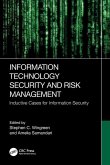Handbook of Risk and Crisis Communication
Herausgeber: Heath, Robert L.; O'Hair, H. Dan
Handbook of Risk and Crisis Communication
Herausgeber: Heath, Robert L.; O'Hair, H. Dan
- Broschiertes Buch
- Merkliste
- Auf die Merkliste
- Bewerten Bewerten
- Teilen
- Produkt teilen
- Produkterinnerung
- Produkterinnerung
The Handbook of Risk and Crisis Communication explores the scope and purpose of risk, and its counterpart, crisis, to facilitate the understanding of these issues from conceptual and strategic perspectives. With perspectives from psychology, sociology, anthropology, political science, economics, and communication, the Handbook of Risk and Crisis Communication enlarges the approach to defining and recognizing risk and how should it best be managed. It provides vital insights for all disciplines studying risk, including communication, public relations, business, and psychology, and will be…mehr
Andere Kunden interessierten sich auch für
![The Construction of Truth in Contemporary Media Narratives about Risk The Construction of Truth in Contemporary Media Narratives about Risk]() John GaffeyThe Construction of Truth in Contemporary Media Narratives about Risk40,99 €
John GaffeyThe Construction of Truth in Contemporary Media Narratives about Risk40,99 €![Practical Project Risk Management, Third Edition Practical Project Risk Management, Third Edition]() David HillsonPractical Project Risk Management, Third Edition57,99 €
David HillsonPractical Project Risk Management, Third Edition57,99 €![Artificial Intelligence and Big Data for Financial Risk Management Artificial Intelligence and Big Data for Financial Risk Management]() Artificial Intelligence and Big Data for Financial Risk Management198,99 €
Artificial Intelligence and Big Data for Financial Risk Management198,99 €![Information Technology Security and Risk Management Information Technology Security and Risk Management]() Information Technology Security and Risk Management42,99 €
Information Technology Security and Risk Management42,99 €![Basic Python in Finance Basic Python in Finance]() Bob MatherBasic Python in Finance29,99 €
Bob MatherBasic Python in Finance29,99 €![Basic Python in Finance Basic Python in Finance]() Bob MatherBasic Python in Finance27,99 €
Bob MatherBasic Python in Finance27,99 €![A Felon's Guide to Financial Recovery A Felon's Guide to Financial Recovery]() Robert E BarthA Felon's Guide to Financial Recovery58,99 €
Robert E BarthA Felon's Guide to Financial Recovery58,99 €-
-
-
The Handbook of Risk and Crisis Communication explores the scope and purpose of risk, and its counterpart, crisis, to facilitate the understanding of these issues from conceptual and strategic perspectives. With perspectives from psychology, sociology, anthropology, political science, economics, and communication, the Handbook of Risk and Crisis Communication enlarges the approach to defining and recognizing risk and how should it best be managed. It provides vital insights for all disciplines studying risk, including communication, public relations, business, and psychology, and will be required reading for scholars and researchers investigating risk and crisis in various contexts.
Hinweis: Dieser Artikel kann nur an eine deutsche Lieferadresse ausgeliefert werden.
Hinweis: Dieser Artikel kann nur an eine deutsche Lieferadresse ausgeliefert werden.
Produktdetails
- Produktdetails
- Verlag: Taylor & Francis Inc
- Seitenzahl: 696
- Erscheinungstermin: 6. Mai 2010
- Englisch
- Abmessung: 254mm x 178mm x 37mm
- Gewicht: 1260g
- ISBN-13: 9780805857788
- ISBN-10: 0805857788
- Artikelnr.: 25409146
- Herstellerkennzeichnung
- Libri GmbH
- Europaallee 1
- 36244 Bad Hersfeld
- gpsr@libri.de
- Verlag: Taylor & Francis Inc
- Seitenzahl: 696
- Erscheinungstermin: 6. Mai 2010
- Englisch
- Abmessung: 254mm x 178mm x 37mm
- Gewicht: 1260g
- ISBN-13: 9780805857788
- ISBN-10: 0805857788
- Artikelnr.: 25409146
- Herstellerkennzeichnung
- Libri GmbH
- Europaallee 1
- 36244 Bad Hersfeld
- gpsr@libri.de
Robert L. Heath is a retired Professor of Communication at the University of Houston. He edited the Handbook of Public Relations and more recently the Encyclopedia of Public Relations. He also co-edited Responding to Crisis with Dan Millar. He has engaged in risk communication studies since the early 1990s, primarily related to the relationship between chemical manufacturing complexes and near neighbors. H. Dan O'Hair is Dean of the College of Communications and Information Studies at the University of Kentucky. He has published over ninety research articles and scholarly chapters in risk and health communication, public relations, business communication, media management, and psychology journals and volumes, and has authored and edited fifteen books in the areas of communication, risk management, health, and terrorism.
Section One: Exploring the Reach of Crisis and Risk Communication Chapter 1: The Significance of Risk and Crisis Communication
Robert L. Heath & Dan O'Hair Chapter 2: Historical Trends in Risk and Crisis Communication
Michael J. Palenchar Chapter 3: Cultural Theory and Risk
James Tansey and Steve Rayner Chapter 4: Risk Communication: Insights and Requirements for Designing Successful Communication Programs on Health and Environmental Hazards
Ortwin Renn Chapter 5: Conceptualizing Crisis Communication
W. Timothy Coombs Chapter 6: The Precautionary Principle and Risk Communication
Steve McGuire and Jaye Ellis Section Two: Key Constructs in Risk and Crisis Communication Chapter 7: Strategies for Overcoming Challenges to Risk Communication
Vincent Covello Chapter 8: Risk Communication Education for Local Emergency Manager: Using the CAUSE Model for Research
Education
and Outreach
Kathy Rowen
Carl Botan
Gary Kreps
Sergi Samoilenko
and Karen Farnsworth. Chapter 9: Risk and Social Dramaturgy
Ingar Palmlund Chapter 10: Myths and Maxims of Risk and Crisis Communication
Peter A. Anderson and Brian H. Spitzberg Chapter 11: The Ecological Perspective and Other Ways to (Re)Consider Cultural Factors in Risk Communication
Linda Aldoory Chapter 12: Science Literary and Risk Analysis: Relationship to the Postmodernist Critique
Conservative Christian Activists
and Professional Obfuscators
Mike Ryan Chapter 13: Influence Theories: Rhetorical
Persuasion
and Informational
Jeff Springston
Elizabeth Johnson Avery
and Lynne M. Sallot Chapter 14: Raising the Alarm and Calming Fears: Perceived Threat and Efficacy During Risk and Crisis
Anthony J. Roberto
Catherine E. Goodall
and Kim Witte Chapter 15: Crisis Response Communication
Image Restoration
and Apologia
Rob Ulmer
Matt Seeger et al. Chapter 16: Risk Communication by Organizations: The Back Story
Caron Chess and Branden Johnson Chapter 17: Ethical Responsibility and Guidelines for Management Issues of Risk and Risk Management
Shannon Bowen Chapter 18: Linking Public Participation and Decision Making through Risk Communication
Katherine McComas
Joseph Arvai
and John C. Besley Chapter 19: Warming Warnings: Global Challenges of Risk and Crisis Communication
David McKie and Christopher Galloway Chapter 20: Risk
Crisis
and Mediated Communication
Kurt Neurwirth Chapter 21: Crises and Risk in Cyberspace
Kirk Hallahan Chapter 22: Virtual Risk: The Role of New Media in Violent and Nonviolent Ideological Groups
Matthew T. Allen
Amanda D. Angie
Josh L. Davis
Cristina L. Byrne
H. Dan O'Hair
Shane Connelly
and Michael D. Mumford Chapter 23: Community Building through Communication Infrastructures
Robert L. Heath
Michael Palenchar
and Dan O'Hair Section Three: Contexts of Crisis and Risk Communication Chapter 24: Crisis and Emergency Risk Communication in Health Contexts: Applying the CDC Model to Pandemic Influenza
Matthew W. Seeger
Barbara Reynolds
and Timothy L. Sellnow Chapter 25: How People Think about Cancer: A Mental Approach
Julie S. Down
Wandi Bruine de Bruin
Baruch Fischhoff
Bradford Hesse
and Ed Maibach Chapter 26: Killing and Other Campus Violence: Restorative Enrichment of Risk and Crisis Communication
Cindi Atkinson
Courtney Vaughn
and Jami VanCamp Chapter 27: Denial
Differentiation & Apology: On the Use of Apologia in Crisis Management
Keith Hearit and Kasie Mitchell Robeson Chapter 28: Risk Communication and Biotechnology: A Discourse Perspective
Shirley Leitch and Judy Motion Chapter 29: Precautionary Principle and Biotechnology: Regulators Are from Mars and Activists Are from Venus
Stephanie Proutheau and Robert L. Heath Chapter 30: Environmental Quality
Tarla Peterson and Jessica Leigh Thompson Chapter 31: Knowing Terror: On the Epistemology and Rhetoric of Risk
Kevin J. Ayotte
H. Dan O'Hair
and Daniel Rex Bernard Chapter 32: Magnifying Risk and Crisis: The Influence of Communication Technology on Contemporary Global Terrorism
Michael D. Bruce
Kristin Shamas
and Dan O'Hair Chapter 33: Opportunity Knocks: Putting Communication Research into the Travel and Tourism Risk and Crisis Literature
Lynne M. Sallot
Jeffrey K. Springston
and Elizabeth Johnson Avery
Robert L. Heath & Dan O'Hair Chapter 2: Historical Trends in Risk and Crisis Communication
Michael J. Palenchar Chapter 3: Cultural Theory and Risk
James Tansey and Steve Rayner Chapter 4: Risk Communication: Insights and Requirements for Designing Successful Communication Programs on Health and Environmental Hazards
Ortwin Renn Chapter 5: Conceptualizing Crisis Communication
W. Timothy Coombs Chapter 6: The Precautionary Principle and Risk Communication
Steve McGuire and Jaye Ellis Section Two: Key Constructs in Risk and Crisis Communication Chapter 7: Strategies for Overcoming Challenges to Risk Communication
Vincent Covello Chapter 8: Risk Communication Education for Local Emergency Manager: Using the CAUSE Model for Research
Education
and Outreach
Kathy Rowen
Carl Botan
Gary Kreps
Sergi Samoilenko
and Karen Farnsworth. Chapter 9: Risk and Social Dramaturgy
Ingar Palmlund Chapter 10: Myths and Maxims of Risk and Crisis Communication
Peter A. Anderson and Brian H. Spitzberg Chapter 11: The Ecological Perspective and Other Ways to (Re)Consider Cultural Factors in Risk Communication
Linda Aldoory Chapter 12: Science Literary and Risk Analysis: Relationship to the Postmodernist Critique
Conservative Christian Activists
and Professional Obfuscators
Mike Ryan Chapter 13: Influence Theories: Rhetorical
Persuasion
and Informational
Jeff Springston
Elizabeth Johnson Avery
and Lynne M. Sallot Chapter 14: Raising the Alarm and Calming Fears: Perceived Threat and Efficacy During Risk and Crisis
Anthony J. Roberto
Catherine E. Goodall
and Kim Witte Chapter 15: Crisis Response Communication
Image Restoration
and Apologia
Rob Ulmer
Matt Seeger et al. Chapter 16: Risk Communication by Organizations: The Back Story
Caron Chess and Branden Johnson Chapter 17: Ethical Responsibility and Guidelines for Management Issues of Risk and Risk Management
Shannon Bowen Chapter 18: Linking Public Participation and Decision Making through Risk Communication
Katherine McComas
Joseph Arvai
and John C. Besley Chapter 19: Warming Warnings: Global Challenges of Risk and Crisis Communication
David McKie and Christopher Galloway Chapter 20: Risk
Crisis
and Mediated Communication
Kurt Neurwirth Chapter 21: Crises and Risk in Cyberspace
Kirk Hallahan Chapter 22: Virtual Risk: The Role of New Media in Violent and Nonviolent Ideological Groups
Matthew T. Allen
Amanda D. Angie
Josh L. Davis
Cristina L. Byrne
H. Dan O'Hair
Shane Connelly
and Michael D. Mumford Chapter 23: Community Building through Communication Infrastructures
Robert L. Heath
Michael Palenchar
and Dan O'Hair Section Three: Contexts of Crisis and Risk Communication Chapter 24: Crisis and Emergency Risk Communication in Health Contexts: Applying the CDC Model to Pandemic Influenza
Matthew W. Seeger
Barbara Reynolds
and Timothy L. Sellnow Chapter 25: How People Think about Cancer: A Mental Approach
Julie S. Down
Wandi Bruine de Bruin
Baruch Fischhoff
Bradford Hesse
and Ed Maibach Chapter 26: Killing and Other Campus Violence: Restorative Enrichment of Risk and Crisis Communication
Cindi Atkinson
Courtney Vaughn
and Jami VanCamp Chapter 27: Denial
Differentiation & Apology: On the Use of Apologia in Crisis Management
Keith Hearit and Kasie Mitchell Robeson Chapter 28: Risk Communication and Biotechnology: A Discourse Perspective
Shirley Leitch and Judy Motion Chapter 29: Precautionary Principle and Biotechnology: Regulators Are from Mars and Activists Are from Venus
Stephanie Proutheau and Robert L. Heath Chapter 30: Environmental Quality
Tarla Peterson and Jessica Leigh Thompson Chapter 31: Knowing Terror: On the Epistemology and Rhetoric of Risk
Kevin J. Ayotte
H. Dan O'Hair
and Daniel Rex Bernard Chapter 32: Magnifying Risk and Crisis: The Influence of Communication Technology on Contemporary Global Terrorism
Michael D. Bruce
Kristin Shamas
and Dan O'Hair Chapter 33: Opportunity Knocks: Putting Communication Research into the Travel and Tourism Risk and Crisis Literature
Lynne M. Sallot
Jeffrey K. Springston
and Elizabeth Johnson Avery
Section One: Exploring the Reach of Crisis and Risk Communication Chapter 1: The Significance of Risk and Crisis Communication
Robert L. Heath & Dan O'Hair Chapter 2: Historical Trends in Risk and Crisis Communication
Michael J. Palenchar Chapter 3: Cultural Theory and Risk
James Tansey and Steve Rayner Chapter 4: Risk Communication: Insights and Requirements for Designing Successful Communication Programs on Health and Environmental Hazards
Ortwin Renn Chapter 5: Conceptualizing Crisis Communication
W. Timothy Coombs Chapter 6: The Precautionary Principle and Risk Communication
Steve McGuire and Jaye Ellis Section Two: Key Constructs in Risk and Crisis Communication Chapter 7: Strategies for Overcoming Challenges to Risk Communication
Vincent Covello Chapter 8: Risk Communication Education for Local Emergency Manager: Using the CAUSE Model for Research
Education
and Outreach
Kathy Rowen
Carl Botan
Gary Kreps
Sergi Samoilenko
and Karen Farnsworth. Chapter 9: Risk and Social Dramaturgy
Ingar Palmlund Chapter 10: Myths and Maxims of Risk and Crisis Communication
Peter A. Anderson and Brian H. Spitzberg Chapter 11: The Ecological Perspective and Other Ways to (Re)Consider Cultural Factors in Risk Communication
Linda Aldoory Chapter 12: Science Literary and Risk Analysis: Relationship to the Postmodernist Critique
Conservative Christian Activists
and Professional Obfuscators
Mike Ryan Chapter 13: Influence Theories: Rhetorical
Persuasion
and Informational
Jeff Springston
Elizabeth Johnson Avery
and Lynne M. Sallot Chapter 14: Raising the Alarm and Calming Fears: Perceived Threat and Efficacy During Risk and Crisis
Anthony J. Roberto
Catherine E. Goodall
and Kim Witte Chapter 15: Crisis Response Communication
Image Restoration
and Apologia
Rob Ulmer
Matt Seeger et al. Chapter 16: Risk Communication by Organizations: The Back Story
Caron Chess and Branden Johnson Chapter 17: Ethical Responsibility and Guidelines for Management Issues of Risk and Risk Management
Shannon Bowen Chapter 18: Linking Public Participation and Decision Making through Risk Communication
Katherine McComas
Joseph Arvai
and John C. Besley Chapter 19: Warming Warnings: Global Challenges of Risk and Crisis Communication
David McKie and Christopher Galloway Chapter 20: Risk
Crisis
and Mediated Communication
Kurt Neurwirth Chapter 21: Crises and Risk in Cyberspace
Kirk Hallahan Chapter 22: Virtual Risk: The Role of New Media in Violent and Nonviolent Ideological Groups
Matthew T. Allen
Amanda D. Angie
Josh L. Davis
Cristina L. Byrne
H. Dan O'Hair
Shane Connelly
and Michael D. Mumford Chapter 23: Community Building through Communication Infrastructures
Robert L. Heath
Michael Palenchar
and Dan O'Hair Section Three: Contexts of Crisis and Risk Communication Chapter 24: Crisis and Emergency Risk Communication in Health Contexts: Applying the CDC Model to Pandemic Influenza
Matthew W. Seeger
Barbara Reynolds
and Timothy L. Sellnow Chapter 25: How People Think about Cancer: A Mental Approach
Julie S. Down
Wandi Bruine de Bruin
Baruch Fischhoff
Bradford Hesse
and Ed Maibach Chapter 26: Killing and Other Campus Violence: Restorative Enrichment of Risk and Crisis Communication
Cindi Atkinson
Courtney Vaughn
and Jami VanCamp Chapter 27: Denial
Differentiation & Apology: On the Use of Apologia in Crisis Management
Keith Hearit and Kasie Mitchell Robeson Chapter 28: Risk Communication and Biotechnology: A Discourse Perspective
Shirley Leitch and Judy Motion Chapter 29: Precautionary Principle and Biotechnology: Regulators Are from Mars and Activists Are from Venus
Stephanie Proutheau and Robert L. Heath Chapter 30: Environmental Quality
Tarla Peterson and Jessica Leigh Thompson Chapter 31: Knowing Terror: On the Epistemology and Rhetoric of Risk
Kevin J. Ayotte
H. Dan O'Hair
and Daniel Rex Bernard Chapter 32: Magnifying Risk and Crisis: The Influence of Communication Technology on Contemporary Global Terrorism
Michael D. Bruce
Kristin Shamas
and Dan O'Hair Chapter 33: Opportunity Knocks: Putting Communication Research into the Travel and Tourism Risk and Crisis Literature
Lynne M. Sallot
Jeffrey K. Springston
and Elizabeth Johnson Avery
Robert L. Heath & Dan O'Hair Chapter 2: Historical Trends in Risk and Crisis Communication
Michael J. Palenchar Chapter 3: Cultural Theory and Risk
James Tansey and Steve Rayner Chapter 4: Risk Communication: Insights and Requirements for Designing Successful Communication Programs on Health and Environmental Hazards
Ortwin Renn Chapter 5: Conceptualizing Crisis Communication
W. Timothy Coombs Chapter 6: The Precautionary Principle and Risk Communication
Steve McGuire and Jaye Ellis Section Two: Key Constructs in Risk and Crisis Communication Chapter 7: Strategies for Overcoming Challenges to Risk Communication
Vincent Covello Chapter 8: Risk Communication Education for Local Emergency Manager: Using the CAUSE Model for Research
Education
and Outreach
Kathy Rowen
Carl Botan
Gary Kreps
Sergi Samoilenko
and Karen Farnsworth. Chapter 9: Risk and Social Dramaturgy
Ingar Palmlund Chapter 10: Myths and Maxims of Risk and Crisis Communication
Peter A. Anderson and Brian H. Spitzberg Chapter 11: The Ecological Perspective and Other Ways to (Re)Consider Cultural Factors in Risk Communication
Linda Aldoory Chapter 12: Science Literary and Risk Analysis: Relationship to the Postmodernist Critique
Conservative Christian Activists
and Professional Obfuscators
Mike Ryan Chapter 13: Influence Theories: Rhetorical
Persuasion
and Informational
Jeff Springston
Elizabeth Johnson Avery
and Lynne M. Sallot Chapter 14: Raising the Alarm and Calming Fears: Perceived Threat and Efficacy During Risk and Crisis
Anthony J. Roberto
Catherine E. Goodall
and Kim Witte Chapter 15: Crisis Response Communication
Image Restoration
and Apologia
Rob Ulmer
Matt Seeger et al. Chapter 16: Risk Communication by Organizations: The Back Story
Caron Chess and Branden Johnson Chapter 17: Ethical Responsibility and Guidelines for Management Issues of Risk and Risk Management
Shannon Bowen Chapter 18: Linking Public Participation and Decision Making through Risk Communication
Katherine McComas
Joseph Arvai
and John C. Besley Chapter 19: Warming Warnings: Global Challenges of Risk and Crisis Communication
David McKie and Christopher Galloway Chapter 20: Risk
Crisis
and Mediated Communication
Kurt Neurwirth Chapter 21: Crises and Risk in Cyberspace
Kirk Hallahan Chapter 22: Virtual Risk: The Role of New Media in Violent and Nonviolent Ideological Groups
Matthew T. Allen
Amanda D. Angie
Josh L. Davis
Cristina L. Byrne
H. Dan O'Hair
Shane Connelly
and Michael D. Mumford Chapter 23: Community Building through Communication Infrastructures
Robert L. Heath
Michael Palenchar
and Dan O'Hair Section Three: Contexts of Crisis and Risk Communication Chapter 24: Crisis and Emergency Risk Communication in Health Contexts: Applying the CDC Model to Pandemic Influenza
Matthew W. Seeger
Barbara Reynolds
and Timothy L. Sellnow Chapter 25: How People Think about Cancer: A Mental Approach
Julie S. Down
Wandi Bruine de Bruin
Baruch Fischhoff
Bradford Hesse
and Ed Maibach Chapter 26: Killing and Other Campus Violence: Restorative Enrichment of Risk and Crisis Communication
Cindi Atkinson
Courtney Vaughn
and Jami VanCamp Chapter 27: Denial
Differentiation & Apology: On the Use of Apologia in Crisis Management
Keith Hearit and Kasie Mitchell Robeson Chapter 28: Risk Communication and Biotechnology: A Discourse Perspective
Shirley Leitch and Judy Motion Chapter 29: Precautionary Principle and Biotechnology: Regulators Are from Mars and Activists Are from Venus
Stephanie Proutheau and Robert L. Heath Chapter 30: Environmental Quality
Tarla Peterson and Jessica Leigh Thompson Chapter 31: Knowing Terror: On the Epistemology and Rhetoric of Risk
Kevin J. Ayotte
H. Dan O'Hair
and Daniel Rex Bernard Chapter 32: Magnifying Risk and Crisis: The Influence of Communication Technology on Contemporary Global Terrorism
Michael D. Bruce
Kristin Shamas
and Dan O'Hair Chapter 33: Opportunity Knocks: Putting Communication Research into the Travel and Tourism Risk and Crisis Literature
Lynne M. Sallot
Jeffrey K. Springston
and Elizabeth Johnson Avery








